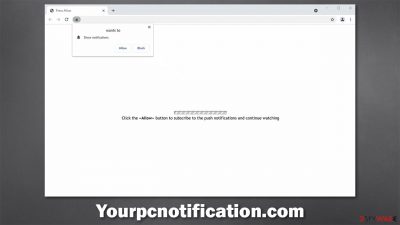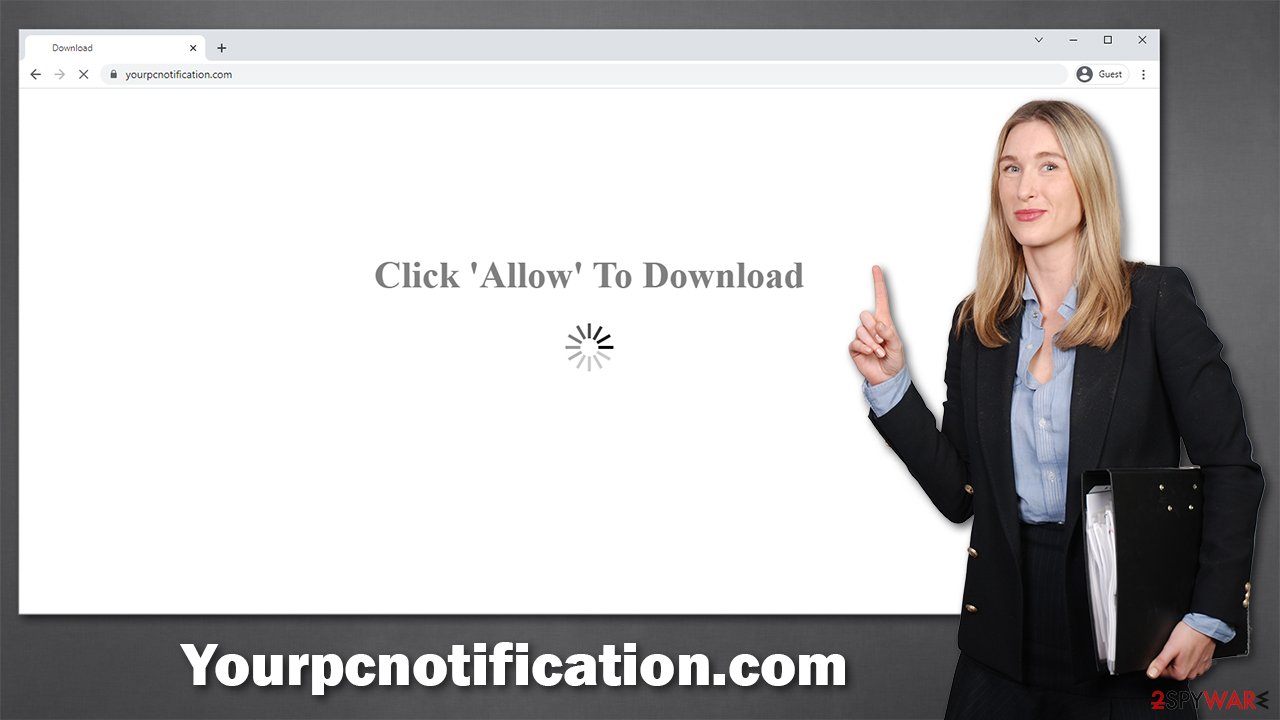Yourpcnotification.com ads (scam) - Free Instructions
Yourpcnotification.com ads Removal Guide
What is Yourpcnotification.com ads?
Yourpcnotification.com is a scam site that tricks users into subscribing to expensive, useless services

Yourpcnotification.com is just one of the thousands of scam websites that target users who are not quite sure about how the push notification feature on Google Chrome or another web browser works. The main goal of scammers is to benefit from ad clicks, which are delivered directly to their screens as often as possible. Users do not voluntarily subscribe to endanger themselves with potentially dangerous links but are rather tricked into it.
Typically, various fake messages and pictures are used to trick people. Website developers try to make sure that less experienced computer users press the “Allow” button as soon as they enter, without thinking too much about it. The element of surprise is one of the main aspects of social engineering, and the push notification feature is simply used as a tool to reach the goals of easy monetization.
Users are commonly not aware that, by pressing that button within the notification prompt, they allowed Yourpcnotification.com to deliver any type of information, displayed as short messages, that typically reroute to some suspicious or even dangerous websites once clicked.
The activity can also be very annoying. It does not matter whether users are watching a movie, reading an article on their favorite outlet site, or working using the browser – they receive intrusive pop-ups that are shown on top of all other apps.
Besides, while unexpected push notifications are not necessarily a sign of a computer infection, this possibility should not be excluded and a system check should be performed as a precautionary measure. In this article, we will answer the most common questions by victims of the scam and include the instructions for pop-up removal process.
| Name | Yourpcnotification.com |
|---|---|
| Type | Push notifications, pop-ups, ads, redirects |
| Distribution | Redirects from malicious websites |
| Symptoms | Soon after the “Allow” button is pressed within the notification prompt, push notifications would show up on the screen at random times |
| Dangers | Installation of potentially unwanted programs or malware, data loss, information leak, financial losses due to encountered scams |
| Deletion | Notifications can be disabled via the browser settings; in case you experience more ads and redirects to suspicious sites, you should also get rid of adware – use SpyHunter 5Combo Cleaner antivirus for quick elimination |
| Further steps | Cleaning web browsers is just as important when dealing with potentially unwanted programs, so do so by following the instructions below or use FortectIntego for a quicker solution |
How did I end up on Yourpcnotification.com?
It is obvious that you did not type in the website URL into the omnibar in order to reach it – most people would not even know the website name in the first place. In most cases, users end up in such dubious places after being redirected from somewhere else on the internet.
For example, one of the most common places where users could be before they end up on Yourpcnotification.com is illegal software websites – torrents, warez, software crack distribution sites. These places can be particularly dangerous as ransomware, Trojans, cryptominers, and another type of malware is spread with the help of those.
Usually, people click on the fake “Download” button or are taken by a redirect with the help of automatic scripts. To avoid these issues, we strongly advise you to stay away from high-risk sites – gambling, torrents, illegal video streaming, etc. Otherwise, you might be redirected to Flatcapspriggy.cam, TowerCaptcha.top, Defimedia.best, or similar sites or have malware installed automatically after such redirects (can occur when software with vulnerabilities is installed on the system).
Another reason for redirects is adware. This type of potentially unwanted software is commonly spread via software bundles or other deceptive methods, hence users might not even be aware they have it installed in the first place. To check your system for adware and malware, we recommend running a scan with SpyHunter 5Combo Cleaner or Malwarebytes security software which would find and eliminate suspicious and malicious programs automatically for you.
Also, malware could damage your operating system, thus if you are experiencing system crashes, errors, BSODs,[1] and similar issues, we recommend using FortectIntego to repair corrupted files and restore normal function within just a few minutes.

What are push notifications?
Push notifications are a relatively old feature that was first introduced by Apple back in 2009.[2] The tech giant realized that pushing the message with important information would allow people to see it immediately and they would pay attention more. Within a secure environment, push notifications can be particularly useful, e.g., users are likely to see an alert of an incoming email or a posting of their favorite YouTube channel.
That being said, push notifications are still surrounded by mystery to many. On one side, many users have spotted the notification prompts that are shown to them as soon as they enter a particular website. They are free to agree or decline the offer by pressing Allow or Block accordingly.
In other words, the push notification feature is not malicious and is intended to be used by websites and users for them to receive the information they are interested in. Surprisingly, the experiment by Mozilla in 2019 showed that 99% of users did not agree to this proposition and 48% even actively blocked it. To tackle this problem, Mozilla made the push notification feature less intrusive in its Firefox browser.[3]
How do push notification scams work?
While originally, push notifications were created to help users access the information on the spot from sources they trust, it does not mean they can't be exploited by various crooks and scammers. Since the feature uses system-level functionality, it makes it the perfect opportunity for actors to generate money through ads – as long as they convince users to subscribe to these notifications.
As evident, not many would subscribe to websites of dubious nature, so crooks came up with a quick solution – they simply created a fake site that holds no purpose other than tricking users into subscribing to notifications. In order to achieve their goal, they show misleading messages right in the middle of the page. Here are a few examples you might encounter:
- Click allow to verify, that you are not a robot
- Click Allow to close this window
- Click “Allow” to continue streaming
- Your file is ready to download – press ALLOW to continue, etc.
These messages are designed in a way to present them as something different. For example, the robot check is a common practice used by many websites to prevent bot attacks, which would consequently make them crash. People might think that this is similar and press the Allow button while thinking it is indeed a security check.
However, you should not interact with either “Block” or “Allow” and leave the site immediately. Otherwise, you would be redirected to similar or even more dangerous websites. For example, you might be asked to enter your phone number or other sensitive information.
How to remove Yourpcnotification.com?
The root of the problem is the permission that was granted by you for a website to show you push notifications. However, since you are likely to be tricked into doing so, you might not even realize that that is the root cause of the problem. Luckily, you can undo this easily by following the instructions below.
Google Chrome
- Open Google Chrome browser and go to Menu > Settings.
- Scroll down and click on Advanced.
- Locate the Privacy and security section and pick Site Settings > Notifications.
![Stop notifications on Chrome PC 1 Stop notifications on Chrome PC 1]()
- Look at the Allow section and look for a suspicious URL.
- Click the three vertical dots next to it and pick Block. This should remove unwanted notifications from Google Chrome.
Mozilla Firefox
- Open Mozilla Firefox and go to Menu > Options.
- Click on Privacy & Security section.
- Under Permissions, you should be able to see Notifications. Click the Settings button next to it.
- In the Settings – Notification Permissions window, click on the drop-down menu by the URL in question.
- Select Block and then click on Save Changes. This should remove unwanted notifications from Mozilla Firefox.
![Stop notifications on Mozilla Firefox 2 Stop notifications on Mozilla Firefox 2]()
MS Edge (Chromium)
- Open Microsoft Edge, and go to Settings.
- Select Site permissions.
- Go to Notifications on the right.
- Under Allow, you will find the unwanted entry.
- Click on More actions and select Block.
![Stop notifications on Edge Chromium Stop notifications on Edge Chromium]()
MS Edge (legacy)
- Open Microsoft Edge, and click the Settings and more button (three horizontal dots) at the top-right of the window.
- Select Settings and then go to Advanced.
- Under Website permissions, pick Manage permissions and select the URL in question.
![Stop notifications on Edge 1 Stop notifications on Edge 1]()
- Toggle the switch to the left to turn notifications off on Microsoft Edge.
![Stop notifications on Edge 2 Stop notifications on Edge 2]()
Safari
- Click on Safari > Preferences…
- Go to the Websites tab and, under General, select Notifications.
- Select the web address in question, click the drop-down menu and select Deny.
![Stop notifications on Safari Stop notifications on Safari]()
Chrome (Android)
- Open Google Chrome and tap on Settings (three vertical dots).
- Select Notifications.
- Scroll down to the Sites section.
- Locate the unwanted URL and toggle the button to the left (Off setting).
![Stop notifications on Chrome Android Stop notifications on Chrome Android]()
How to prevent from getting adware
Protect your privacy – employ a VPN
There are several ways how to make your online time more private – you can access an incognito tab. However, there is no secret that even in this mode, you are tracked for advertising purposes. There is a way to add an extra layer of protection and create a completely anonymous web browsing practice with the help of Private Internet Access VPN. This software reroutes traffic through different servers, thus leaving your IP address and geolocation in disguise. Besides, it is based on a strict no-log policy, meaning that no data will be recorded, leaked, and available for both first and third parties. The combination of a secure web browser and Private Internet Access VPN will let you browse the Internet without a feeling of being spied or targeted by criminals.
No backups? No problem. Use a data recovery tool
If you wonder how data loss can occur, you should not look any further for answers – human errors, malware attacks, hardware failures, power cuts, natural disasters, or even simple negligence. In some cases, lost files are extremely important, and many straight out panic when such an unfortunate course of events happen. Due to this, you should always ensure that you prepare proper data backups on a regular basis.
If you were caught by surprise and did not have any backups to restore your files from, not everything is lost. Data Recovery Pro is one of the leading file recovery solutions you can find on the market – it is likely to restore even lost emails or data located on an external device.
- ^ Chris Hoffman. Everything You Need To Know About the Blue Screen of Death. How-to Geek. Site that explains technology.
- ^ A decade of push notifications: Where push is today. Adjust. Braze Blog.
- ^ M.J. Kelly. Say goodbye to annoying notification requests (unless you want them). Mozilla. Blog.







